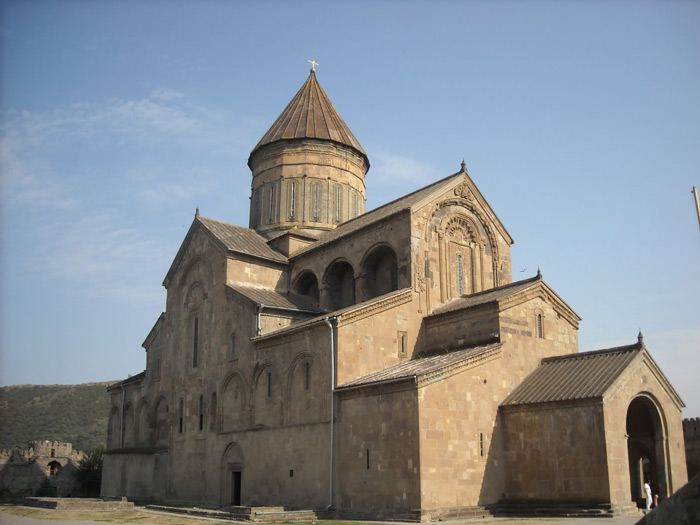Historical relics in the ancient city of Mtskheta
Unesco's Scientific, Educational and Cultural Organization has recognized the historical sites in Georgia's ancient city of Mtskheta as a World Cultural Heritage in 1994.

The ancient city of Mtskheta is one of the oldest ancient cities in Georgia. The city is located at the confluence of the Aragvi and Mt'k'vari rivers, about 20 km northeast of the capital, Tbilisi. The city is located in the eastern part of Kartli province. Currently the city has about 8,000 people as the administrative center of Mtskheta-Mtinaneti region.
Historical sites in the city are located in Unesco recognized populations dating back over 1000 BC.
Historically, the ancient city of Mtskheta used to be the capital of the Georgian kingdom of Iberia from the 3rd century BC until the 5th century AD. This city was also the first place where kito religion appeared in the kingdom and this religion officially became the state religion in 317. Until today the ancient city of Mtskheta is still the headquarters of the Orthodox Apostolic Church. Georgia.

From the beginning of the 6th century, King Dachi I Ujarmeli (successor of Vakhtang I Gorgasali) moved the capital from the old city of Mtskheta to Tbilisi. The move of the capital was done according to the wishes of his father. Although it is no longer the capital, the city is still used as a venue for the burial ceremonies and burial grounds of many Georgian kings. This took place over the centuries until the end of the royal dynasty in the 19th century.

Historical monuments in the ancient city of Mtskheta include many architectural works of historical and artistic value, including the Svetiskhoveli Cathedral; Jvari Monastery; Fort Armaztsikhe; Armaztsikhe defense .
Svetiskhoveli cathedral was built in the 11th century, while Jvari monastery was built in the 6th century. Both of these buildings are important architectural works of Christian architecture. in Georgia. Not only that, these two works have a great historical significance in developing medieval architecture throughout the Caucasus region. The scripts stored at Svetiskhoveli Cathedral and Jvari Monastery are also the basis for studying the origins of ancient Georgian alphabet systems.

Fort Armaztsikhe was built in the 3rd century BC while Armaztsikhe citadel was built in the 1st century BC. The legacy of the Pompey Bridge follows the legend of the Roman legion army of Pompey the Great in the first century BC also known as Armaztsikhe castle. The discrete monuments of the royal palace are now left in the first century AD, a small church built in the 4th century and the Samtavro monastery built in the 11th century; The fortress of Bebris Tshikhe was built in the 14th century. In addition, the archaeological building and the garden Mikheil Mamulashvili are also important works of art and history in the ancient city of Mtskheta.

Historical relics in the ancient city of Mtskheta are recognized by Unesco according to criteria (iii), (iv)
Criterion (iii): The historical relics in the ancient city of Mtskheta are the cultural works of the Georgian kingdom of Iberia which are no longer present. These structures play an important role in the development of medieval architecture and culture in Georgia.
Criterion (iv): Historical sites in ancient city Mtskheta is also the outstanding architectural works of Christianity in Georgia. Svetiskhoveli Cathedral and Jvari Monastery can be said to be the prominent religious architecture of medieval church religious architecture in the Caucasus region, representing various stages of ant art development. architecture from the 4th to 8th centuries.

- Video: Ancient relics in the tunnel in Mexico
- Finding ancient bronze books in Chinese characters in Ha Tinh
- Complex of Hue ancient relics
- Discover the remains of an ancient city on the outskirts of Vienne
- Laser map the ancient city in Jordan
- Sigirya Citadel - the mysterious beauty of the capital, few people dare to discover
- Krakow - The ancient capital of Poland
- Discovering many vestiges and ancient relics in Ho Citadel
- Discover ancient wells that have never run out of water
- Admire the most magnificent city ruins of ancient times
- A nearly 900-year-old Cham well was discovered in Quang Nam
- 10 ancient cities have disappeared completely from the world map
 Suzhou classic bonsai garden - China
Suzhou classic bonsai garden - China Chau Nguyen Dynasty
Chau Nguyen Dynasty Thai Son Mountain - World Wonder
Thai Son Mountain - World Wonder Ancient villages of Shirakawa-go and Gokayama
Ancient villages of Shirakawa-go and Gokayama